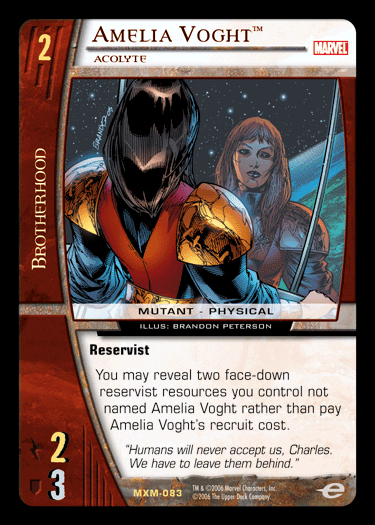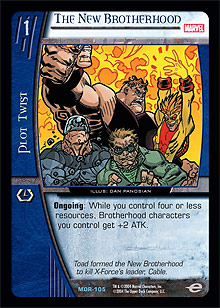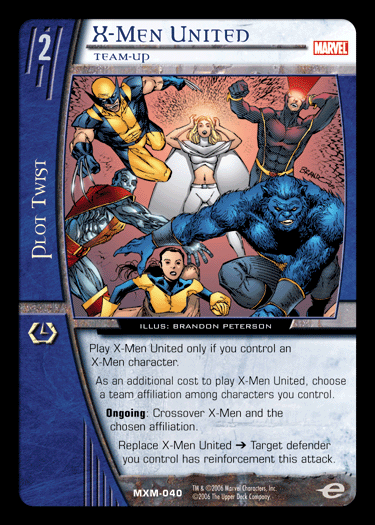
No word is more likely to arouse the attention of a TCG player than “free.” Any time a player can get some amount of value out of something that cost him or her nothing in return, that player has a decided advantage. This is the reason that lacking plot twists is just as devastating as missing character drops. Since plot twists cost nothing (or close to nothing) to play, a player with a bunch of plot twists can create tangible benefits for him or herself for nothing in return. This is also the reason that Savage Beatdown remains the most powerful combat modifier; in a world where everything costs nothing, the card that generates the biggest number (with no drawback in return) is likely to be the best of the bunch.
Characters, however, are never free. While some characters have alternate recruit costs, in those cases all you’ve changed is the nature of the cost requirement. Also, since these characters are traditionally 1-drops, you generally don’t get a great return, even for the low cost of discarding a card. The reason that Rick Jones has made the largest splash of the bunch is that (besides being on a powerful team) he is a reservist (thus enabling your various reservist effects) and a concealed character with an activated ability—he is in essence another plot twist that happens to say “reservist” on him. Sabretooth, Feral Rage is basically a 5-drop at the cost of 4 resource points and a card, but again, you’ve only changed the investment requirement. Not to say that Rick and Sabretooth aren’t good cards, as they are some of the best their respective teams have to offer. Rather, the point is that characters always cost something, be it cards, resource points, something else, or a combination of costs. The only real exception to this rule is Mr.
Mxyzptlk, but he also has a pretty steep cost in another sense (you have to be playing Revenge Squad), and his impact is largely meaningless.

Marvel X-Men ushers in the first truly free character that you’ll actually want to play—Amelia Voght. As a 2 ATK / 3 DEF for 2 without flight or range, she is slightly below average for what we expect out of a 2-drop these days. This would be a pretty significant problem, except that Amelia isn’t really a 2-drop at all. For the “cost” of revealing two reservists out of the resource row, Amelia comes into play free of charge. The Brotherhood will be a reservist team, not unlike the Avengers, and anyone familiar with that team knows that having two reservists in your resource row is more of a given than a cost or restriction. Furthermore, anyone familiar with New Brotherhood–style builds of Brotherhood decks knows how powerful having a bunch of reservists in that deck would be. Amelia is a powerful enabler for both reservist decks (if she were an Avengers character, I’m sure some number would immediately be included in that deck) and for short curve New Brotherhood decks in the wake of Marvel X-Men and the onslaught of Brotherhood reservists.
For starters, just having a free character in New Brotherhood is a powerful effect. New Brotherhood has traditionally played some of the worst characters in tournament history just to achieve a certain density of characters for The New Brotherhood, Savage Land, and other combat enablers. Amelia amounts to at least 2 free extra ATK each turn, and potentially quite a bit more in conjunction with the deck’s namesake. Also, since the deck has to play a bunch of different characters to ensure use of all of its resource points every turn, characters often end up in the row, and as the game progresses into later turns, those characters could have been of use. Having reservists is a great way of skirting this problem.
 Not only that, but reservists interact very well with The New Brotherhood itself. The traditional Brotherhood deck caps its curve on 5 with Magneto, Eric Lehnsherr, hopefully followed by a Genosha to refuel its hand and get back down to the desired four resources. If one doesn’t have a Genosha, the game can get very awkward on the fifth turn; do you not lay a resource on the fifth turn and recruit inferior characters to keep The New Brotherhood online, or do you recruit your best character but turn off your best plot twist for the remainder of the game? No matter what the answer, a tremendous sacrifice has to be made. However, if your resource row is full of reservists, the problem is solved. On turn 5, recruit your Magneto. On turn 6, lay a resource, fire a couple of reservists out of your row, get back down to four resources, and blow your opponent out. It’s a very simple and effective formula all made possible by reservists.
Not only that, but reservists interact very well with The New Brotherhood itself. The traditional Brotherhood deck caps its curve on 5 with Magneto, Eric Lehnsherr, hopefully followed by a Genosha to refuel its hand and get back down to the desired four resources. If one doesn’t have a Genosha, the game can get very awkward on the fifth turn; do you not lay a resource on the fifth turn and recruit inferior characters to keep The New Brotherhood online, or do you recruit your best character but turn off your best plot twist for the remainder of the game? No matter what the answer, a tremendous sacrifice has to be made. However, if your resource row is full of reservists, the problem is solved. On turn 5, recruit your Magneto. On turn 6, lay a resource, fire a couple of reservists out of your row, get back down to four resources, and blow your opponent out. It’s a very simple and effective formula all made possible by reservists.
Amelia also has the extra bonus of being good anytime you draw her. Most of the time, your extra characters are close to worthless draws. The best you can hope for is a power-up, and even for that there is a finite window. If you recruit a 2-drop on turn 2, it will usually be KO’d by the end of turn 4. If you draw that character on turn 5, good luck getting any value out of it. But Amelia is a great draw at any stage. As long as you have the two reservists in your row, she is always free, be it on turn 2 or turn 7.
Furthermore, any additional draws of Amelia are excellent, even while you already have one in play. You can make attacks that are normally poor from a board presence standpoint, knowing that you can just replace her with a fresh one on the following turn or the next time you have the initiative. No character in the history of the game has ever been this flexible in terms of what window you need to draw it by, since the window for this card is always open.
I anticipate that Amelia and her reservist buddies will help out a Brotherhood team that has been on the downslide in Golden Age for some time. I also expect that she’ll interact quite well with the Avengers in the upcoming Modern Age format. Vs. System, like most TCGs, is about maximizing efficiency, and there is nothing more efficient than free. Pick up four of these at your Sneak Preview and dust off your copies of The New Brotherhood, because the original off-curve team is going to be near the top of Golden Age once again.
Editor’s Note: Crossover Defined
Those of you who have been following the online X-Men previews may have seen the new term “crossover,” and you are no doubt wondering what it means. Here’s the definition you’ll see on the boxtopper inserted into every booster box:
If a card you control says to "crossover" two or more team affiliations, it means to team-up those affiliations on characters you control and character cards you own in all zones. A "character card you own" is defined as a character card that started the game in your deck. Crossover applies to:
• Characters you control (including any owned by an opponent);
• Character cards you own in your hand, deck, and KO'd pile;
• Character cards you own that are on the chain or have been removed from the game;
• Character cards you own in any resource row; and
• Character cards you own that are controlled by an opponent.

In a nutshell, crossover is an easier way to say “team-up.” I’m sure Mike Hummel will have more to say about this new term in future articles, and Paul Ross will clarify any rules questions you may have in a future Cerebro.
- TW

Tomorrow's Preview: